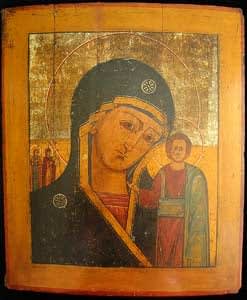The Mother of God of Kazan, 19th Century CE
Tempera on Wood
17.375
PF.5692
Inseparable from the liturgical tradition, religious art is seen by Orthodox Christians as a form of pictorial confession of faith and a channel of religious experience. Because the icons provide...
Inseparable from the liturgical tradition, religious art is seen by Orthodox Christians as a form of pictorial confession of faith and a channel of religious experience. Because the icons provide direct personal contact with the holy persons represented on them, these images were objects of veneration, in either a public or private setting, and were even believed to have the ability to heal.
This is a touching portrait of a mother and child. However, just in relation to the size of the figures, partly explained by their different ages, Mary is given much more prominence. The style is derived from earlier Byzantine mosaics and paintings, typical of Orthodox art. This influence is most evident in Mary's facial structure, including her linear nose, round geometric eyes, and arching brows, in the angular treatment of the infant Christ's drapery, and in the relative special isolation of the composition, void of any elaboration of environment or setting. Two miniature saints can be seen in the distance over the Virgin's right shoulder. Above all, this is an intimate scene between mother and child. We see our own selves in them. This work, like many icons, seeks to combine the familiar and the divine into one. This is both a mother and child, and Mary and Christ. They are both human, like us; yet holy, worthy of our adoration and veneration.
This is a touching portrait of a mother and child. However, just in relation to the size of the figures, partly explained by their different ages, Mary is given much more prominence. The style is derived from earlier Byzantine mosaics and paintings, typical of Orthodox art. This influence is most evident in Mary's facial structure, including her linear nose, round geometric eyes, and arching brows, in the angular treatment of the infant Christ's drapery, and in the relative special isolation of the composition, void of any elaboration of environment or setting. Two miniature saints can be seen in the distance over the Virgin's right shoulder. Above all, this is an intimate scene between mother and child. We see our own selves in them. This work, like many icons, seeks to combine the familiar and the divine into one. This is both a mother and child, and Mary and Christ. They are both human, like us; yet holy, worthy of our adoration and veneration.



